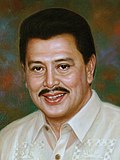This article needs additional citations for verification .(June 2023) |
| Date | June 30, 1998 |
|---|---|
| Location | Barasoain Church Malolos, Bulacan |
| Participants | President of the Philippines, Joseph Estrada Assuming office Chief Justice of the Supreme Court of the Philippines,Andres Narvasa Administering oath Vice President of the Philippines Gloria Macapagal Arroyo Assuming office Chief Justice of the Supreme Court of the Philippines, Andres Narvasa Administering oath Transition Team of Joseph Estrada and Presidential Transition Coordination Team |
| ||
|---|---|---|
Early political career Mayor of San Juan
Senator of the Philippines
Vice President of the Philippines Political affiliations
Public image Post-Presidency Elections | ||
The inauguration of Joseph Estrada as the thirteenth president of the Philippines took place on Tuesday, June 30, 1998, at the Barasoain Church in Malolos, Bulacan. The oath of office was administered by Chief Justice of the Supreme Court of the Philippines Andres Narvasa. Afterwards, Estrada delivered his inaugural speech at the Quirino Grandstand in Manila. [1] The inauguration was held during the Centennial of Philippine Independence. The Inauguration was organized jointly by the Presidential Transition Cooperation Team of outgoing President Fidel V. Ramos and the Transition Team of incoming President Estrada. This was the last presidential oath administered by Narvasa.
Contents
Estrada resigned amidst the Second EDSA Revolution on January 20, 2001, two years, six months, and twenty-one days into his term. The then Vice President Gloria Macapagal Arroyo assumed the office of President.
